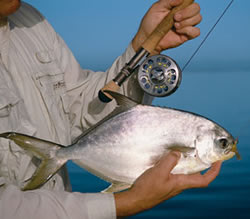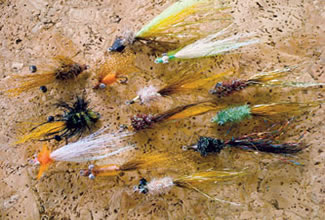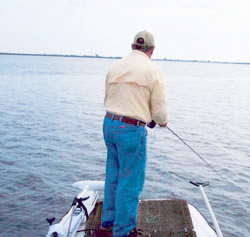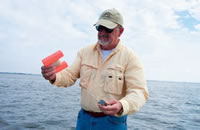November 16, 2012
By Ron Kowalyk
Tune up for pompano in the inshore mix.

Scrappy pompano clober bright, flashy lfies fished with sinking fly lines. |
At the drop of the hat, Dick Carline and Pete Sullivan are ready to jump aboard my boat for some fly fishing in Estero Bay or up north a ways at Punta Rassa. Winter trips are casual affairs and we don't rush out much before 8 or 9 a.m., when it's too cold for grandpa's old bones. I think the fish feel the same way. We're birds of a feather, nothing especially fancy about the tackle. Dick, a retired engineer, has his favorite 20-year-old, 7-weight rod, which he casts with elegant ease. Pete, who gave up tool and die work in Massachusetts, can punch out a steady stream of 50- to 60-foot casts with a very modest 6-weight rod. Our usual winter targets are seatrout, ladyfish, bluefish and Spanish mackerel. Lately we've added pompano to the mix. Here's how.
The first pompano show in early autumn along the lower Florida Gulf Coast, and we continue to catch them until late spring. We've found schools of the fat and sassy “yellow bellies” skipping along the surface on many of the hard-bottom flats and the pothole patches in the bays and passes. These areas tend to have good tidal movement throughout the day and are often affected by wave action. Also, close proximity to the Gulf means high salinity—good for pompano and their forage.
Traditionally, pompano are fished in the surf with special attention to the sloughs formed by wave action just off the beach. Large sandbars like those off Sanibel Light House beach can also be hotspots. My home waters include San Carlos Bay and the spoil islands that are part of the Sanibel Causeway. These islands and bridges create bottlenecks that amplify the tidal current. The several bridges, channels and adjacent deep flats just off the Gulf are prime for pompano, whiting and black drum.
When targeting pompano, it's a good idea to fly fish over sparse cover, generally mixed bottom. This is not to say they will not invade lush grassbeds that hold trout. Pompano will generally feed more actively along the perimeter of grassbeds, favoring deeper flats than trout, so fishing in four to even 10 feet of water is typical. Pompano will feed on large open expanses of hard bottom that are usually devoid of trout. Hard-bottom areas spotted with shells and old crab traps are great habitat for crustaceans, which account for pompano catches. Pompano also congregate in deep potholes, especially during low water. For example, northern Pine Island Sound is peppered with the remnants of craters made during World War II. The area was used as a bombing range and today these craters are referred to as “The Bombing Range.”
The surest sign of pompano is “skippers,” pomps that zoom out of the water when alerted. They skip in your boat wake when under power, but also when you drift over them. This adds a modified sight fishing flavor to the hunt. Where you see skipping fish, cast and fish your flies thoroughly and patiently. Florida anglers have mixed feelings about this. Some say they skip and don't eat; others report catching them with ease where they skip out of the water. In areas where great masses of pompano migrate, schools of foraging fish can even create visible plumes of mud. Make a few casts into any muds that you observe on the flats in late winter and spring. Pompano will also trail large rays, groups of rays or even a manatee in order to pick up tasty morsels kicked up in their wakes.

Effective impressionistic shrimp and minnow flies. |
A good depthfinder rigged for reporting temperature data can be a great help. You'll find that the pomps tend to hang at the same depth even on different drifts on any given day. That depth represents a comfort zone. That zone may be only a degree or two different from the surrounding water. This info is especially valuable on days when the fish aren't in a “skippy mood,” like after a strong cold front moves through.
Make your first few presentations as tight to the bottom as possible. Pompano are generally foraging head down, tail up, checking out any telltale movement, puff or flash on or near the bottom. They are largely sight feeders, so keep your offering in the strike zone, only a few inches off the bottom. Take into account the speed of your drift, sink rate of your sinking fly line (yes, you will need one), leader length and fly weight. Although your floating line can work in four feet or less with a heavy sinking fly, forget it in deeper water. Give the fly time to get down—drop your rodtip almost to the water after casting and just wait a good 10 to 15 seconds before you make your first strips. The rodtip-down position is fundamental; this allows for the greatest range of motion when it comes time to pick up a heavy fly and sinking line. The position also helps when strip-setting the hook. Furthermore, it'll help you detect short strikes (common with pomps) and eliminates slack that makes it tough to set the hook.

Proper rod tip position for stripping and hook-setting. |
Keep your line under control with a stripping basket or a “fuzzy rug.” I use the plastic fake grass mats when the wind is strong. Pompano will take line once hooked and get on the reel most of the time, so be ready to pick up your rodtip and carefully pay out line. A reel with a good drag and palming rim on the spool will keep things under control, and be ready to walk the gunnels if you hook a big fish! Hooked pompano are frantic and change direction continuously. They especially like to head under the boat, and toward your lower unit.
Another good practice is casting straight out from the bow or stern (at 12 or 6 o'clock position), which allows your line to sink almost drag-free and in turn much faster. This type presentation will very thoroughly cover the deepest section of the water column as it quarters around to 90 degrees while you drift a flat. You may also need to shake a few feet of line out of your rodtip, similar to the “dead drift” approach used by freshwater trout stream fishermen. This is especially helpful when using a floating line or intermediate sinker, teamed with a relatively long, light leader. The faster the sink rate of your fly line the shorter the leader you'll be able to use, a real plus when drifting deep over a ragged bottom. Don't hesitate to make a brisk strip hookset when you feel a possible strike; you can always drop the fly back on a false take.

Toss a floating marker with weight to mark schools. |
Leaders for pompano fishing can be as short as four feet to a maximum of seven feet. Fluorocarbon leader materials are a must, I believe, particularly in clear water. A simple level leader of 20-pound test will suffice if the water is slightly stained or if you encounter jacks, Spanish and bluefish mixed in with the pomps. For clear water or when using particularly small flies, try a 12-pound tippet. Pompano will strike with authority but can be picky.
After you locate a pod of skippers, or hook your first pompano, throw out a floating marker. Since you'll be drifting along, keep the marker at the ready. Roughly triangulating landmarks such as crab pot buoys and other stationary reference points is also a good idea. Taking GPS numbers can help you return to potential hotspots day after day, though pompano usually stay on the move, unless ample food keeps them around.

Drifting anglers score on skipping fish. |
Pompano eat tiny stuff at times, so keep your flies on the small side, 2 1/2 inches or smaller. I prefer flies with a beadhead, large beadchain or lead eyes for sink rate. Champagne-colored, white, root-beer or chartreuse flies dressed to look like minnows or shrimp all score for me. Many fly fishers toss pretty crafty sandflea patterns (available in many coastal fly shops). When in doubt, Clouser Minnows certainly take pompano, but you might want to keep ‘em short because pomps are short-strikers at times. For that matter, you can dress up some flies to look just like jigs—big lead eyes, and whatever skirt color seems to be working for the jiggers in your area.
FS
Originally Published Florida Sportsman March 2006
